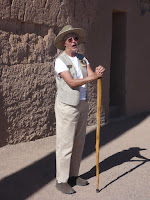My National Park book was pretty vague about what we’d see at the park. I knew that Casa Grande Ruins had been a prehistoric Indian village. I expected something like the cliff dwellings in Walnut Canyon. Was I ever wrong!
As we drove south on AZ 87 out of Mesa, the land was flat and uninteresting. Reminded me some of the Nevada Mojave, but even less interesting. Land flat enough to park a trailer without having to dig out the level, a little bit of mesquite and creosote bush, a cactus once in a while—bo-ring! I kept thinking we’d get closer to the mountains before we entered the park, but suddenly we were within the city limits of Coolidge and the sign showed the NM was off to the right. Around the corner and we were there! Practically across the street from the entrance were a Wal-Mart and a Safeway. Odd to think that a NM was that close to “civilization”; none of the rest of the parks have been.
Out of the car for the requisite pictures of the park sign, and then down the drive to the Visitor’s Center. They have a pretty good exhibit, all about the Hohokam people who lived there a thousand years ago. There’s a large compound, consisting of ruins of houses, platform mounds, a ball court, and of course, the “great house”, Casa Grande. It was 4 stories high, made of caliche mud, timbers and saguaro ribs—all done with primitive stone and wood tools circa 1350, but the archeologists don’t have a clue what it was for… They’ve restored it and protected it by putting concrete over some of the mud, and they covered it with a big steel and concrete canopy in 1932.
Graffiti from early tourists still remain inscribed in the building. My aunt Dot would have said, “Fools names and fools faces are often found in public places.”
We went on the tour with an Interpretive Guide who explained the history of the people and described the irrigation canals that they built. Who would have guessed that they could grow cotton and tobacco in Arizona??? Sure, corn and squash, even food from the cactus—but cotton? I guess I’m as naïve about agriculture as I am about the locations of prehistoric dwellings.
Our guide, Carol Andrews, gave a really interesting talk, and afterwards we talked with her a little bit about becoming a volunteer with the National Parks Service. She gave us several tips that will come in handy when we get ready to try that. I assumed the volunteers would have memorized canned speeches, but she said that they had to do all their own research. That certainly makes it more interesting. I’ll bet Toastmasters experience would come in handy too.
She also showed us the resident great horned owls that live up in the canopy. We had lunch under the picnic ramada. I resisted my inclination to feed the critters (there was a sign), but took pictures of them. George insists that any mammal that burrows in the ground is a gopher, but these little guys were called “Roundtail Ground Squirrels”. Lunchtime entertainment was a couple of doing a bit of a territorial chase-and-chomp. Nighttime entertainment is probably the equally thrilling owl/rodent version.
Back home with a small detour for ice cream. Yes, I can eat ice cream in January; I think the temperature was about 72.More pictures of Casa Grande Ruins NM


Post a comment.
Post a Comment
Please leave comments here: